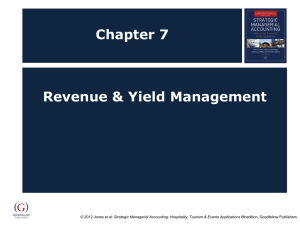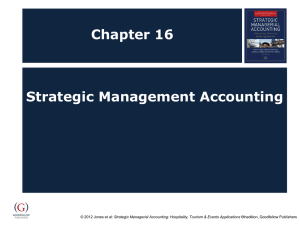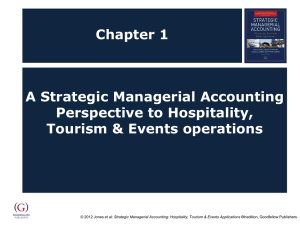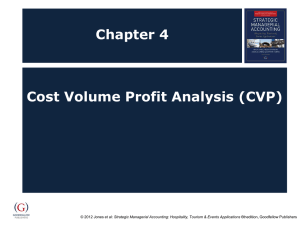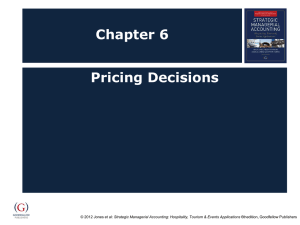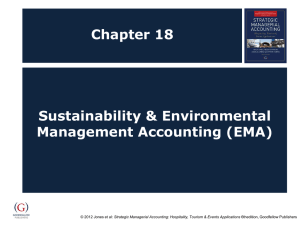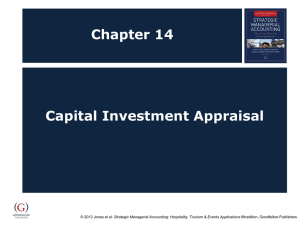Chapter 8 - Goodfellow Publishers
advertisement
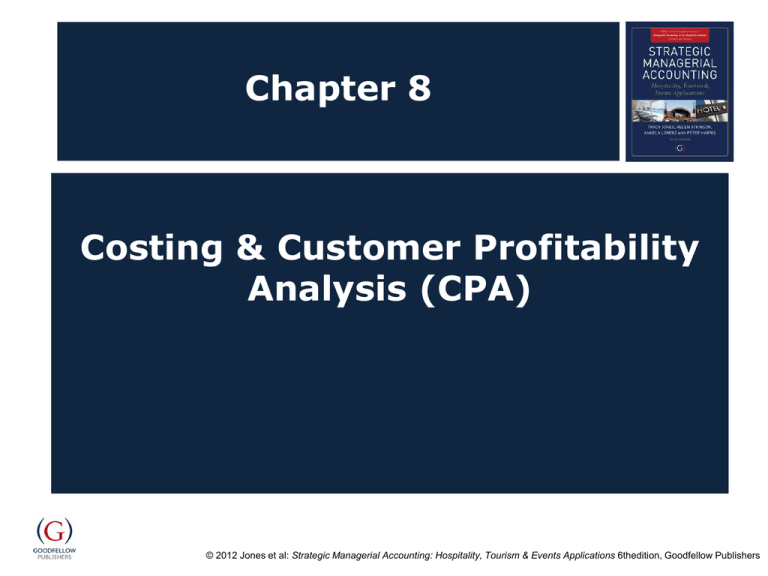
Chapter 8 Costing & Customer Profitability Analysis (CPA) © 2012 Jones et al: Strategic Managerial Accounting: Hospitality, Tourism & Events Applications 6thedition, Goodfellow Publishers Objectives After studying this topic you should be able to: Understand the relationship between the marketing and management accounting functions; Understand and use Activity Based Costing (ABC) and Activity Based Management (ABM) to support management decisions; and Critically evaluate the use of; market segment profitability analysis, customer profitability analysis, and profit sensitivity analysis as tools to aid managers’ in hospitality, tourism and events environments. © 2012 Jones et al: Strategic Managerial Accounting: Hospitality, Tourism & Events Applications 6thedition, Goodfellow Publishers Market decisions An external focus of an organisation leads to decisions as to: Which specific market are we in? Who is our customer? What do these customers want? Can we deliver what they want? Will this make us a profit? Could other markets offer a better profit potential? © 2012 Jones et al: Strategic Managerial Accounting: Hospitality, Tourism & Events Applications 6thedition, Goodfellow Publishers Market and customer examples (1) What market are we in? Events - Weddings Events - Weddings Events – Music festival Events – Music festival Who are our customers? Those who want a bespoke service What do they want? Something designed specifically for them, a ‘one-off’ event, but prepared to pay for this ‘uniqueness’ desired from the event. Those on a budget, They want a memorable day, cost is a but wanting a special concern so they want to select from preday set all-inclusive packages that they can budget for. 18-25 year olds with a Top artists, mixing with like-minded passion for individuals, basic camping facilities, bar contemporary music facilities and a simple food provision. Families A safe friendly environment, with good music for the adults, but also entertainment for the children, with workshops and family focused camping facilities, quality food & drink provision. © 2012 Jones et al: Strategic Managerial Accounting: Hospitality, Tourism & Events Applications 6thedition, Goodfellow Publishers Market and customer examples (2) What market are we in? Hospitality 5* hotel (International Airport) Who are our customers? Airline crew and air passengers Hospitality 5* hotel Overseas travellers at (city centre) the ‘high end’, & corporate executive business travellers Hospitality 5* hotel Entertainment and (city centre) creative industry corporate executives, younger celebrities, ‘young money’ What do they want? A one night stay with easy access to the airport, possibly parking whilst away, 24 hour services so they can arrive, eat and leave at a time convenient to flight needs. Traditional hospitality, opulent surroundings, attention to service details, traditional hotel styling & atmosphere, like-minded customers Want 5* facilities, but with a lively, vibrant modern atmosphere in a hotel with a contemporary style and modern service and up-to-the-minute gadgets and technology. © 2012 Jones et al: Strategic Managerial Accounting: Hospitality, Tourism & Events Applications 6thedition, Goodfellow Publishers marketing/accounting interface (1) © 2012 Jones et al: Strategic Managerial Accounting: Hospitality, Tourism & Events Applications 6thedition, Goodfellow Publishers marketing/accounting interface (2) Scenario Issue Combined solution A coach tour operator contacts the hotels central reservation team, they want to book 30 rooms in your hotel for next March for Saturday night. The numbers of rooms are available to be booked and you have a special discounted rate with this tour operator. The reservation team are rewarded on the number of room sold, the rooms need to be filled and, even at the discounted rate, 30 rooms @ £50 each represents £1,500 sales revenue. From the accountants perspective financial data might show: There is a buoyant weekend break market, booking these rooms for Saturday night will make them difficult to sell Friday for one night – an opportunity cost; This tour operator has been very slow to pay its bills in the past, requiring a lot of chasing and there is concern over their credit rating. This could lead to cash flow problems as the amount of trade receivables (debtors) increases or bad debts in the future; or This is a great opportunity and these customers tend to have a high ‘secondary spend’ in the bar and spa facilities making this a good opportunity. © 2012 Jones et al: Strategic Managerial Accounting: Hospitality, Tourism & Events Applications 6thedition, Goodfellow Publishers marketing/accounting interface (3) Scenario A new spa treatment is priced by the accounting department using a cost-plus approach and calculates the 1 hour treatment should be sold at £65. Issue The accounting team are taking no account of the market, what the customer is prepared to pay or the completion. Combined solution The marketing department establish that there is competition locally offering the same treatment (customers can go elsewhere) and the prices range from £52 - £62. Given this market data the product price can be set considering the market: Set at the lower end of the market, £55 to attract customers in to try the new product; Given the quality and reputation of the spa, priced at £65 to identify it as a premium product in the market; or Set at the psychological price of £59, being under the £60 boundary. © 2012 Jones et al: Strategic Managerial Accounting: Hospitality, Tourism & Events Applications 6thedition, Goodfellow Publishers Activity Based Costing (ABC) "A system of management which uses activity based cost information for a variety of purposed including cost reduction, cost modelling and customer profitability analysis." (CIMA official terminology) © 2012 Jones et al: Strategic Managerial Accounting: Hospitality, Tourism & Events Applications 6thedition, Goodfellow Publishers Key elements of ABC include: 1. Cost visibility - Brings costs out into the open and allows managers to ask if their department is as cost effective as it could be. 2. Activity cost profile - This is a way of presenting data (like an overhead reporting statement) allowing the asking of questions like why has the cost of quality control risen. 3. Identifying value added - Allows differentiation between costs which add value and those which don't. This can be used for further development into three categories core, support and discretionary costs. This enables better cost management by reducing resources on non-core activities. 4. Cost behaviour patterns - It is not always clear how and why cost behave as they do. An ABC based cost hierarchy can identify how costs are driven and again focus on cost reduction. © 2012 Jones et al: Strategic Managerial Accounting: Hospitality, Tourism & Events Applications 6thedition, Goodfellow Publishers ABC simple example A hotel stores department issues out drink stock to various hotel departments as follows: Stores Department Stock value Restaurant £12,000 Bar £8,000 Room Service Lounge £1,000 £3,000 Totals £24,000 Running the stores for a week costs £600 and this cost needs to be covered by the stock © 2012 Jones et al: Strategic Managerial Accounting: Hospitality, Tourism & Events Applications 6thedition, Goodfellow Publishers Solution A traditional absorption costing approach would be to share this equally across the stock value: £600/£24,000 = £0.025 Stores Department Stock value Absorption rate per £ of stock Restaurant 12,000 £0.025 £300 Room Service Bar 1,000 8,000 Lounge 3,000 Totals 24,000 £25 £75 £600 £200 © 2012 Jones et al: Strategic Managerial Accounting: Hospitality, Tourism & Events Applications 6thedition, Goodfellow Publishers Solution (cont) Stores Department Stock value Absorption rate per £ Number of issues per week Restaurant 12,000 £0.025 £300 1 Room Bar Service 8,000 1,000 £200 £25 3 14 Lounge 3,000 £75 Totals 24,000 £600 7 25 The ‘driver’ for this cost relates to the work the stores department undertake in issuing, the ‘activity’ of processing a stock requisition. ABC would share this cost based on usage of the activity. © 2012 Jones et al: Strategic Managerial Accounting: Hospitality, Tourism & Events Applications 6thedition, Goodfellow Publishers Solution (cont) ABC = £600/25 = £24 per stock issue Stores Department Stock value Absorption rate per £ Number of issues per week ABC rate Restaurant 12,000 £0.025 £300 Bar 8,000 £200 Room Service 1,000 £25 1 £24 3 £72 14 £336 £24 Lounge 3,000 £75 Totals 24,000 £600 7 £168 25 £600 © 2012 Jones et al: Strategic Managerial Accounting: Hospitality, Tourism & Events Applications 6thedition, Goodfellow Publishers ABC uses It can aid managers in identifying services, products, departments and activities that are profitable or those making a loss; It can aid operational level financial control; It can identify unnecessary costs for management action; and It can be used in cost-plus pricing (see pricing chapter). © 2012 Jones et al: Strategic Managerial Accounting: Hospitality, Tourism & Events Applications 6thedition, Goodfellow Publishers Activity Based Management (ABM) Operational ABM: ‘Actions, based on activity driver analysis, that increase efficiency, lower costs and/or improve asset utilisation.’ CIMA Official Terminology, 2005 Strategic ABM: ‘Actions, based on activity based cost analysis, that aim to change the demand for activities so as to improve profitability.’ CIMA Official Terminology, 2005. © 2012 Jones et al: Strategic Managerial Accounting: Hospitality, Tourism & Events Applications 6thedition, Goodfellow Publishers Customer Profitability Analysis (CPA) CPA uses the ABC approach to costing to track costs by activities associated with customers, not individual products and services. © 2012 Jones et al: Strategic Managerial Accounting: Hospitality, Tourism & Events Applications 6thedition, Goodfellow Publishers Customer profitability Analysis in action (1) Sector Tourism Events ‘Bundled’ Products/services – bought as combined package Products/services – bought individually The packaged tour, including in one price: Plane travel, transfers, accommodation, and all meals. Plane travel, transfers, accommodation, meals, travel insurance, currency exchange, day trips, drinks, upgrades, car hirer. VIP package, including in one price: Event ticket, programme, hospitality food & drink package. Event ticket, programme, food, drink, merchandising, travel. © 2012 Jones et al: Strategic Managerial Accounting: Hospitality, Tourism & Events Applications 6thedition, Goodfellow Publishers Customer profitability Analysis in action (2) Sector ‘Bundled’ Products/services – bought as combined package Hospitality Full board – room, breakfast, lunch & dinner Products/services – bought individually Room, breakfast, lunch, dinner, bar sales, in-room entertainment, spa treatments, golf green fees, merchandising. © 2012 Jones et al: Strategic Managerial Accounting: Hospitality, Tourism & Events Applications 6thedition, Goodfellow Publishers Traditional v. CPA approach Traditional Hotel Accounting Approach Customer Profitability Analysis Operating Departments Revenue by Customer Group (e.g. rooms, restaurants, bars, spa, conference) Department generates Revenue Operating Departments Costs and overhead expenses Activities Operating Departments Costs and overhead expenses Profit by Customer Group Total profit from all Operating Departments Non- allocated costs Total Profits (Adapted from Harris 2011) © 2012 Jones et al: Strategic Managerial Accounting: Hospitality, Tourism & Events Applications 6thedition, Goodfellow Publishers CPA example © 2012 Jones et al: Strategic Managerial Accounting: Hospitality, Tourism & Events Applications 6thedition, Goodfellow Publishers How can CPA aid managers’ decision making? (1) explicitly identifying which customer groups (segments) generate the most profit can aid the targeting of resources and marketing efforts to these groups; providing information that can aid cost reduction, by highlighting costs by activities gives managers’ the chance to review the need of activities or how their costs can be reduced; assisting pricing of products, particularly packages and discounting for certain customer groups; © 2012 Jones et al: Strategic Managerial Accounting: Hospitality, Tourism & Events Applications 6thedition, Goodfellow Publishers How can CPA aid managers’ decision making? (2) allowing markets to be segmented on profitability, not just revenues; aiding a differentiation strategy; providing information for making more informed decisions. © 2012 Jones et al: Strategic Managerial Accounting: Hospitality, Tourism & Events Applications 6thedition, Goodfellow Publishers Profit Sensitivity Analysis (PSA) Profit sensitivity analysis is another tool to aid managers’ in understanding their business in more detail. As the name suggests, PSA concerns understanding how sensitivity profits are to changes, these could be changes in revenues, or changes in specific costs. An example would be: What is the impact on profits if an individual variable (volume, selling price, or a cost element) changes by 10%? © 2012 Jones et al: Strategic Managerial Accounting: Hospitality, Tourism & Events Applications 6thedition, Goodfellow Publishers PSA Profit multiplier = % change in profit % change in key factor © 2012 Jones et al: Strategic Managerial Accounting: Hospitality, Tourism & Events Applications 6thedition, Goodfellow Publishers PSA Example © 2012 Jones et al: Strategic Managerial Accounting: Hospitality, Tourism & Events Applications 6thedition, Goodfellow Publishers PSA use and criticisms Gives an understanding of impact changes, therefore what to focus management time on controlling. However it ignores the likelihood of such changes and views them in isolation. © 2012 Jones et al: Strategic Managerial Accounting: Hospitality, Tourism & Events Applications 6thedition, Goodfellow Publishers Summary To maximise profits you need to focus on the most profitable customers, but need a mechanism to know who they are. The combined roles of marketing and the accounting function can do so much more than working independently. Activity based costing is an alternative to traditional absorption costing and proves more useful in service situations. Customer Profitability Analysis (CPA) allows managers to identify the profits associates with customers, as opposed individual departments, products or services. In complex environments were customers buy multiple services and products it is customers not products that need to be tracked to maximise financial returns. Profit Sensitivity Analysis (PSA) aids managers in understanding the relationship between individual costs and their impact on profits. © 2012 Jones et al: Strategic Managerial Accounting: Hospitality, Tourism & Events Applications 6thedition, Goodfellow Publishers
